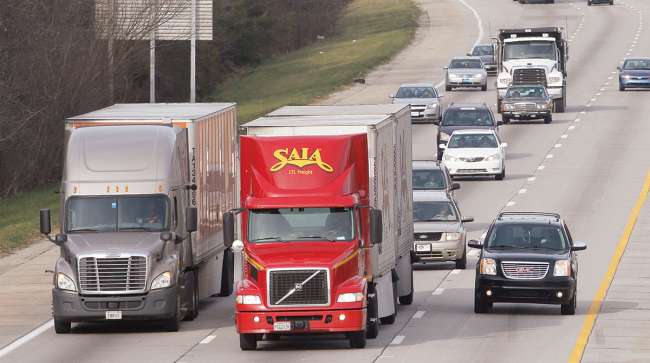Senior Reporter
Truck Tonnage Up 2.4% Year-Over-Year in February

[Stay on top of transportation news: Get TTNews in your inbox.]
Truck tonnage in February increased 2.4% compared with the same month a year ago, and American Trucking Associations’ advanced seasonally adjusted For-Hire Truck Index equaled 115.3, the federation announced March 22.
The index remained unchanged month-to-month, after moving up 0.4% in January, said Bob Costello, ATA’s chief economist.
“February was the first month that the index didn’t increase since July,” Costello said. “Despite a string of gains, the index is still off 1.8% from March 2020. The index is also off 4.2% from the all-time high in August 2019.”

Costello
However, February’s increase was the sixth straight year-over-year gain and the largest over that period. In January, the index was up 0.9% from a year earlier. Year-to-date and compared with same period in 2021, tonnage is up 1.7%.
Costello said that current market conditions include a shortage of at least 80,000 drivers. Difficulties purchasing new and used equipment, especially Class 8 vehicles, also are contributing to the flat month-over-month index number.
“Demand for trucking freight services remains strong, but for-hire contract carriers are capacity constrained due to the driver and equipment markets. The spot market has been surging as these carriers can’t haul all of the freight they are asked to move,” Costello said. “So the fact that the tonnage index hasn’t fully recovered is a supply problem, not a lack of demand.
“Other ATA data shows that for-hire carriers are operating around 7% fewer trucks, both company and independent contractor equipment, than prior to the pandemic.”
The index equaled 100 in 2015.

Host Michael Freeze speaks with TMC Chairman Randy Obermeyer and Brenda Neville of the Iowa Motor Truck Association about how to recruit young drivers and technicians. Hear a snippet above, and get the full program by going to RoadSigns.TTNews.com.
Trucking represents 72.5% of tonnage carried by all modes of domestic freight transportation, including manufactured and retail goods, ATA said. Trucks hauled 10.23 billion tons of freight in 2020, and motor carriers collected $732.3 billion, or 80.4%, of total revenue earned by all transport modes.
The Logistics Managers Index, compiled monthly by a group of academic and business leaders across the country, showed a dramatic increase in February. Researchers said the LMI measured 75.2 — the second-highest in its history — compared with a reading of 71.4 a year ago. In January, the index measured 71.9.
“This is now 13 consecutive months over 70.0, which we would classify as significant expansion, with no obvious signs of a slowdown on the horizon,” the report said. “Like January, this month’s growth is driven by rapid growth in inventory levels. This is a complete 180 from the fall of 2021, when firms struggled to build up inventories. Now it seems that a combination of over-ordering to avoid shortages, late-arriving goods due to supply chain congestion, and a softening of consumer spending has created a logjam.”
Researchers at Arizona State University, Colorado State University, the Rochester Institute of Technology, Rutgers University, and the University of Nevada, Reno, in conjunction with the Council of Supply Chain Management Professionals, manage the data for the report. The LMI is calculated using a diffusion index, in which any reading above 50% indicates that logistics is expanding; a reading below 50% is indicative of a shrinking logistics industry.
Meanwhile, the National Retail Federation is forecasting that retail sales in 2022 will increase between 6% and 8% to total between $4.86 trillion and $4.95 trillion.
“NRF expects retail sales to increase in 2022, as consumers are ready to spend and have the resources to do so,” NRF CEO Matthew Shay said. “We should see durable growth this year given consumer confidence to continue this expansion, notwithstanding risks related to inflation, COVID-19 and geopolitical threats.”
While the 2022 forecast is somewhat lower than the 14% annual growth rate in 2021, it is notably stronger than the 10-year, pre-COVID-19 pandemic growth rate of 3.7%.
The NRF said nonstore and online sales are expected to increase between 11% to 13% to a range of $1.17 trillion to $1.19 trillion as consumers continue to embrace e-commerce.
The NRF projects full-year GDP growth of around 3.5%.

Adamo
Specific to the spot rate market in trucking, the most recent DAT Truckload Volume Index for February saw a 3% decline from January to 227, the group said March 23.
“Spot market rates and volumes naturally decline in February as more truckload freight moves under contract,” DAT Chief of Analytics Ken Adamo said. “Volatile diesel fuel prices have given the market a jolt, and shippers and carriers are reviewing their playbooks for ways to reduce empty miles and improve fuel efficiency.”
Adamo said the recent spike in fuel prices hit smaller carriers especially hard. Since they are less likely to negotiate bulk fuel discounts, price fluctuations more severely impact their cash flow, he noted.
Want more news? Listen to today's daily briefing below or go here for more info:

